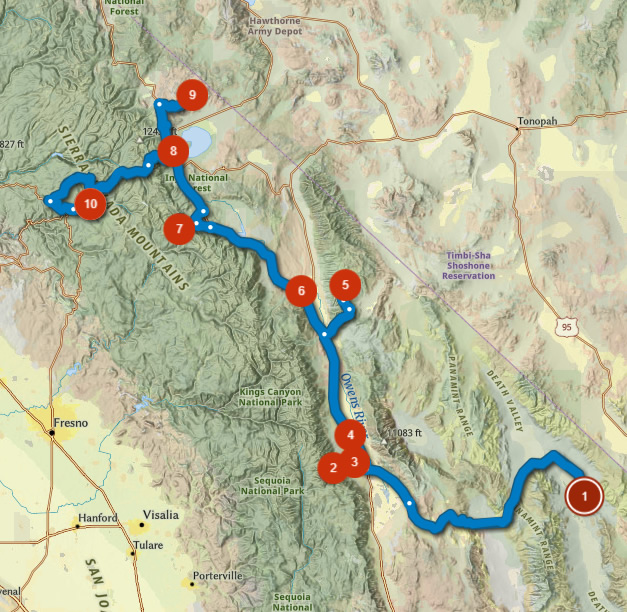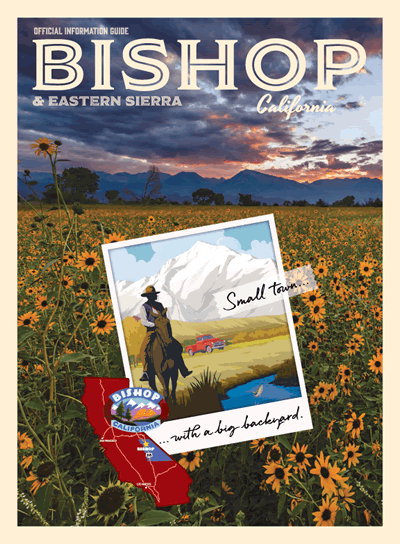Alabama Hills
ALABAMA HILLS: From the center of Lone Pine, turn west onto Whitney Portal Road, go 2.5 miles, then turn right on Movie Road (dirt). This area has long been used as a film location (think Hop A Long Cassidy, John Wayne, etc.) and is one of the most highly photographed areas in California. Ambling among formations of weathered, golden granite, it’s easy to see why these dry hills and boulders, backed by the snowy Sierra, have attracted movie crews since the film industry’s earliest days. hills and boulders, near the snowy Sierra, have attracted film crews since the earliest days. Check out the Quick Guide to the Alabama Hills here!
Art by: Pat Crowther – I paint in watercolor, oil, pastel, pen, ink, and pencil. Sierra views, desert scenes, southwest, portraits and botanical illustrations are my main subject matter. I am a member of the Eastern Sierra Plein Air Artists, a group that meets every Tuesday.
Ancient Bristlecone Pine Forest
ANCIENT BRISTLECONE PINE FOREST: From Big Pine, take Highway 168 east about 13 miles, then turn left onto the Ancient Bristlecone Pine National Scenic Byway. In 8 miles, you’ll reach Sierra View Outlook – a short walk leads to an observation point with an extraordinary view of the Sierra range. Follow the road for a few more miles to reach Schulman Grove, home to the world’s oldest known specimens of bristlecone pine, some well over 4,000 years old.
Watercolor by: Maryann Thomas – “My art has many influences,” Maryann says “in particular are the early 20th-century American painters John Singer Sargent, Winslow Homer, and Georgia O’Keeffe.”
Bishop Creek Canyon
BISHOP CREEK CANYON: Follow Line Street (HWY 168) west of Bishop about 15 miles. You’ll climb into the mountains from the valley floor to elevations over 9,000 feet on a well-maintained elevation over 9,000 feet on a well-maintained highway. Popular locations include South Lake, North Lake, Lake Sabrina, the historic Rainbow Pack Station and Cardinal Gold Mine. The canyon is a real find in autumn, with blazing color igniting the landscape.
Photo by: Roberta McIntosh – Eastern Sierra Photographer who believes, “It’s simple really. If you’re looking to get lost for a few days, for a week, for ten years – you need to head to those places that have dropped off the tourist map, spots where the forests still feel wild, the water still tastes pure, and other people still feel far, far away.”
Buttermilk Country
BUTTERMILK COUNTRY: From downtown Bishop, take Line Street (HWY 168) west approximately 7 miles then turn right onto Buttermilk Road. The “Buttermilks” are named for the dairy farms that once drew stagecoach travelers. Within the first mile, the road skirts around the south end of the dry, stony Tungsten Hills, where several old mines are located on the north side of Buttermilk Road. The barren-looking hills soon give way to a lush strip of Longley Meadow. Follow the graded dirt road to see amazing granite boulder fields and upland meadows beneath impressive Mount Tom and Basin Mountain.
Art by: Janice Kabala – Janice Kabala’s modern landscapes are pared down to the essentials of site; emphasizing line, shape, and color. Simplicity is more difficult to achieve, and makes the artistic process far more contemplative for both the artist and the viewer.
Death Valley
DEATH VALLEY: This is a must-see destination for diverse geologic features, desert wildlife, historic sites, scenery, and clear night skies. Popular locations include Scotty’s Castle, Artists’ Drive, Racetrack Playa, Ubehebe Crater, Zabriskie Point, and Badwater (282’ below sea level). Death Valley is in the southeastern portion of Inyo County. To enter from the west side, head east from Olancha or Lone Pine on State Route 190 – about 1.5 hours of scenic driving to the visitor center at Furnace Creek. From the east side, the entrance to the park is about 2 hours north of Las Vegas.
Art by:Robert Mitchell- Death Valley is a special desert valley located in Eastern California. Situated within the Mojave Desert, it features the lowest, driest, and hottest locations in North America.
Fall Colors
FALL COLORS: In autumn, trees are ablaze in hues of orange, yellow, gold and crimson. From majestic cottonwoods in the Owens Valley to quaking aspens draping the high country, you’ll be delighted by the range of color at various elevations. Fall color timing is very dependent on weather – be sure to check with one of our visitor centers when planning your trip.
Photograph by: Billy Gogesch -My creative work takes inspiration from the expansive beauty of the Eastern Sierra.
Mt. Whitney
MT. WHITNEY: At 14,494’, this is the highest peak in the continental United States. Mount Whitney is a magnificent sight to behold from the town of Lone Pine. For a closer look, travel west on Whitney Portal Road approximately 13 miles to the Whitney Portal Recreation area and trailhead. Those wishing to climb Mt. Whitney must obtain a permit from the Eastern Sierra Interagency Visitor Center (760) 876-6200.
Watercolor by: Jill Kinmont Boothe – Born in Los Angeles, Jill Kinmont grew up in Bishop, California, skiing and racing at Mammoth Mountain. In early 1955, she was the reigning national champion in the slalom, and a top prospect for a medal at the 1956 Winter Olympics, a year away. While competing in the downhill at the Snow Cup in Alta, Utah, on January 30th, 1955, [1] she suffered a near-fatal accident that resulted in paralysis from the neck down. It ironically occurred the same week that Kinmont, weeks shy of her 19th birthday, was featured on the cover of Sports Illustrated magazine dated January 31, 1955.
Night Sky
NIGHT SKY: There are few places that can compare to the absolute river of light which is the night sky of the Eastern Sierra. Our dark skies draw astronomers and photographers from all over the world. It is the perfect place to view stars and meteor showers.
Watercolor by: Don Roberts -Don moved to Bishop in 1979 to fly fish, hike, photograph and ski the Eastern Sierra. Usually you can find him hiking to one of the passes with fly rod and a tripod on his back. His work can be seen here and the local art shows around Bishop.
Wildlife
WILDLIFE: Inyo County is home to many species of plants and animals that have adapted to this high desert environment; Mule Deer, Big Horn Sheep, Mountain Lions, Quail, Eagles, Hawks and Owls, to name a few. South of the city of Big Pine is the Wildlife View Area for Owens Valley’s tule elk herd, a species that was nearly extinct in the 1870s. About 500 tule elk now live here in Owens Valley. More info on wildlife viewing can be found here.
Watercolor by: Nancy Overholtz – Nancy is a watercolor artist living in the high desert town of Bishop, California. Together with her woodturning husband Ron, she exhibits her work at art shows and galleries in California and Nevada.


